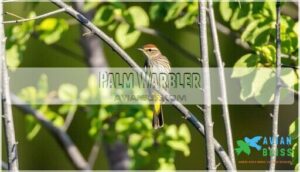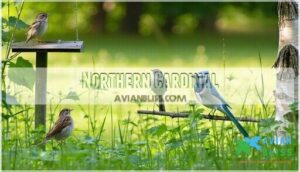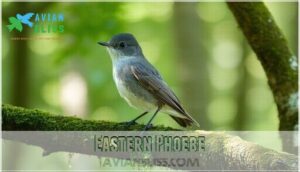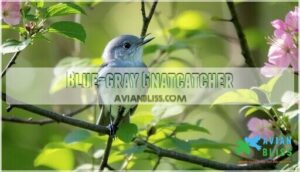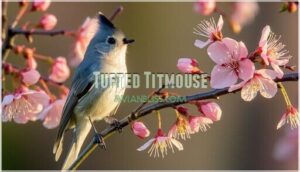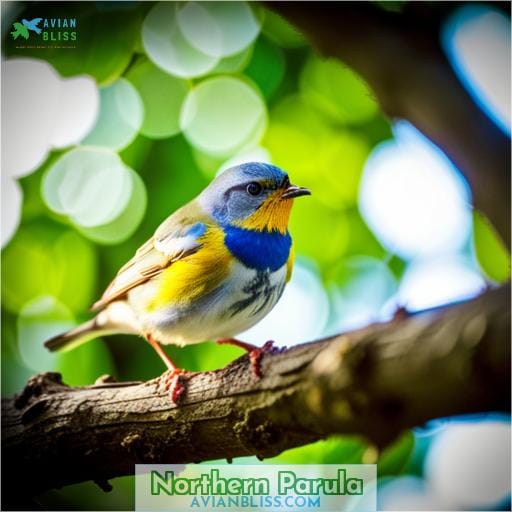This site is supported by our readers. We may earn a commission, at no cost to you, if you purchase through links.

Here we provide photos and information about each species so that you can recognize them when they show up in your area! All these little feathered friends measure nine inches or less in size, making it easy for even novice birders to spot them while enjoying nature’s beauty.
So don’t wait – start learning about all the wonderful kinds of small birds found throughout Florida today!
Table Of Contents
Key Takeaways
- Palm Warbler: Rusty cap, yellow undertail coverts
- Yellow-rumped Warbler: White tail spots, bright yellow patches on the rump and undertail coverts
- Northern Cardinal: Bright red plumage, distinctive crest on the head
- Eastern Phoebe: A year-round resident in Florida, with a distinctive fee-bee song
Palm Warbler
You’ll spot the rusty cap and yellow undertail of a Palm Warbler bobbing through shrubs as you explore Florida’s pine flatwoods and mangrove swamps. These olive-brown songbirds breed in Canada and Alaska before migrating down the Atlantic Coast to winter in the southeastern U.
In Florida, Palm Warblers forage on the ground for insects, seeds and berries. Look for their constant tail-bobbing motion. Males sport a rusty cap, black eyeline and yellow undertail coverts. Females are duller overall.
Palm Warblers are common, yet unassuming winter visitors that bring a touch of the north woods to subtropical Florida.
Yellow-rumped Warbler
The palm warbler finishes its southward migration, and the yellow-rumped warbler arrives for winter. With white tail spots when perched and bright yellow patches on its rump and sides, this warbler is a joy to spot.
It prefers open woodlands, especially pine, oak, and cypress. Watch for it hopping along the ground, flicking its tail. These warblers dine on wax myrtle berries, finding protein in insects and spiders.
To glimpse them, walk trails quietly and watch for quick yellow flashes in the trees. With care and lucky timing, you may capture a photo of one preening its vibrant plumage. As populations decline nationwide, consider creating bird-friendly habitat with native plants.
By enjoying yet protecting these yellow beauties, you aid the future of songbirds in Florida’s forests.
Northern Cardinal
See that bright red bird at the feeder? That’s a northern cardinal, one of the most easily recognized backyard birds in Florida. The male’s brilliant crimson plumage and distinctive crest make it a living ornament in trees and yards.
The northern cardinal is a year-round resident in the South. It prefers edges of woodlands and thickets.
Cardinals eat seeds, fruits, and insects. They forage on the ground and in shrubs and trees. Cardinals are monogamous and may mate for life. The female builds a cup nest of twigs, bark, and grasses in a dense shrub or small tree.
The rich whistled song of the northern cardinal brightens winter days. This bird’s cheerful presence provides comfort in every season.
Eastern Phoebe
The Eastern Phoebe is one of the most common backyard birds in Florida. It lives year-round in the state, nesting under bridges, eaves, and porches. You’ll often see it darting out to catch an insect before returning to its perch.
The Eastern Phoebe builds an open cup nest out of mud, moss, and grass. While not technically a migratory bird, it may wander south during the coldest winter months.
Use a bird identification app to learn the Eastern Phoebe’s field marks like its dark head and white underparts. Watch for this little gray bird hunting insects in your yard or under patio overhangs.
Blue-gray Gnatcatcher
You’ll delight in this tiny flitty bird dashing through the branches with its jerky movements and delicate, high-pitched mew. The blue-gray gnatcatcher is a tiny songbird found year-round in Florida, easily identified by its blue-gray plumage, white eye ring, and long dark tail.
It actively forages in tree canopies, shrubs, and brush for insects, constantly fanning its tail as it hurriedly hops and flutters through foliage.
Though small, it builds an exquisitely woven, compact cup nest on a tree branch, using plant down, moss, and spider silk. While not a long-distance migrant, some northern gnatcatchers may migrate short distances into Florida for the winter.
Watch for these tiny sprites with big personalities in scrubby areas and woodland edges. The blue-gray gnatcatcher’s perpetual motion and soft hues will bring ephemeral beauty to your backyard.
Gray Catbird
Gotta love the Gray Catbird’s unique catty mew song that makes you do a double take as it mimics other birds and sounds.
- Mimicking other species makes catbirds fascinating to observe.
- Watching them defend their territory reveals spirited personality.
- Hearing them mew like kittens evokes surprise and delight.
- Spotting nests in dense shrubs uncovers devotion to family.
- Interacting with these charismatic backyard birds connects us to nature.
These clever mimic-artists sing jazz-like melodies, chattering cat meows, and even car alarms. Blending in with shadows, catbirds forage on insects and berries from forest edges to suburbs. Nesting in thickets, pairs fiercely guard eggs and fledglings. Appreciating catbirds opens our ears to avian voices and deepens ties to native habitats.
Ultimately, the catbird’s song resonates within us, stirring awe of nature’s infinite creativity.
Tufted Titmouse
You’d recognize the Tufted Titmouse by its prominent black forehead crest, gray back, and white underside. This small songbird is a year-round resident in Florida, frequently found in deciduous or mixed woodlands.
The Tufted Titmouse gets its name from the tuft of feathers on its head that are black, with the rest of the body primarily dark gray with white underside. It’s very vocal with a loud peter-peter call. The Tufted Titmouse is attracted to bird feeders, especially those stocked with sunflower seeds.
It builds nests in natural tree cavities or nest boxes about 10 to 20 feet above ground, usually raising one brood per breeding season. The fun Tufted Titmouse is an addition to any backyard habitat, providing color and activity with its jaunty crest and energetic movements.
Watch for it flitting through branches and calling out its signature peter notes.
Northern Parula
With its vibrant blue-green upperparts and yellow throat, the tiny Northern Parula displays one of the most colorful contrasting patterns of the 27 species of small birds commonly found in Florida. This migratory songbird breeds across eastern North America and winters in Florida, the Caribbean, and Central America.
The Northern Parula prefers forested wetlands and is well known for its unique nest – it attaches its nest to hanging lichens. This diminutive bird can be identified by its bright yellow throat outlined in rusty brown and olive-green back with a bold white eye-ring.
Listen for the ascending buzzy trill of the Northern Parula singing from the forest canopy. Though one of the smallest warblers, the Northern Parula’s striking plumage makes it stand out among the many backyard birds that visit Florida.
Carolina Wren
You’ll spot the Carolina wren’s cinnamon brown body and bold white eyebrow as it bustles through shrubbery. This bubbly bird flits through tangled vines and dense brush, picking insects from crevices with its narrow curved bill.
Its loud, variable teakettle song rings out from backyard shrubs. Aggressive and territorial, it will harass cats and other intruders with its tail held upright.
The Carolina wren builds a nest of twigs, grass, and leaves tucked into a cavity or hidden in brush. You may find its large domed nest in a flowerpot, mailbox, or garage door tracks. A year-round resident, its bubbly song livens up the yard even through the winter.
With a little encouragement, this small cinnamon-hued songster may become one of your favorite backyard birds.
Red-winged Blackbird
The boisterous Red-winged Blackbird is a common sight year-round in Florida. You’ll recognize the males by their striking scarlet-and-yellow shoulder patches called epaulets. In spring, listen for their conk-la-ree song as they defend breeding territories in marshes.
These gregarious blackbirds nest in colonies, aggressively chasing off intruders. Their habitat ranges from wetlands to agricultural areas and suburbs. Females are streaky brown and resemble Common Grackles.
Red-wings will often displace smaller birds like Carolina Chickadees and White-eyed Vireos from feeders. But plant some millet or sunflowers, and everyone can share in the bounty. With their energetic social displays and colorful plumage, Red-winged Blackbirds brighten any backyard.
Conclusion
Florida is home to an amazing array of small birds, with 27 species that measure nine inches or less. These range from year-round residents like the Northern Cardinal and Carolina Chickadee to migratory visitors such as the Ruby-crowned Kinglet and Yellow-rumped Warbler.
Many of these small birds visit backyard bird feeders, so it’s easy for bird watchers to identify and observe them. The Palm Warbler, Yellow-rumped Warbler, Northern Cardinal, Eastern Phoebe, Blue-gray Gnatcatcher, Gray Catbird, Tufted Titmouse, Northern Parula, Carolina Wren, and Red-winged Blackbird are just some of the birds you may see in Florida.
With a little patience and the right feeders, you can attract these feathered friends to your backyard and enjoy their beauty and song.

